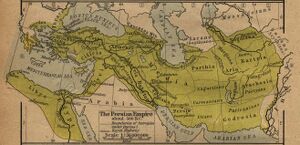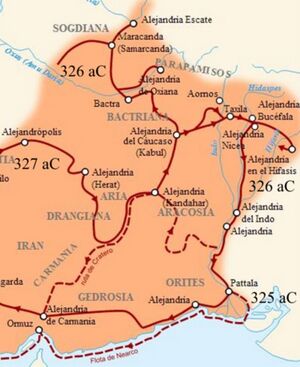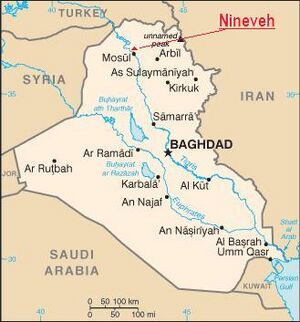Arachotia: Difference between revisions
| Line 10: | Line 10: | ||
*[[Arachosia]] (of [[Xuanzang]]) | *[[Arachosia]] (of [[Xuanzang]]) | ||
*[[Arachosians]] | *[[Arachosians]] | ||
*[[Arachotian]] | |||
*[[Arachotians]] | *[[Arachotians]] | ||
*[[Arachotus]]/[[Arachōtós]] (River ) | *[[Arachotus]]/[[Arachōtós]] (River ) | ||
Revision as of 07:13, 28 July 2018


Arachosia is the Hellenized name of an ancient satrapy in the eastern part of the Achaemenid, Seleucid, Parthian, Greco-Bactrian, and Indo-Scythian empires. According to Arrian, Megasthenes lived in Arachosia and travelled to Pataliputra, to the court of Chandragupta Maurya.
Location
Arachosia was centred on the Arghandab valley in modern-day southern Afghanistan, although its influence extended east to as far as the Indus River. The main river of Arachosia was called Arachōtós, now known as the Arghandab River, a tributary of the Helmand River.[1] The Greek term "Arachosia" corresponds to the Aryan land of Harauti which was around modern-day Helmand. The Arachosian capital or metropolis was called Alexandria Arachosia or Alexandropolis and lay in what is today Kandahar in Afghanistan.[2] Arachosia was a part of the region of ancient Ariana.
Variants of name
- Arachotae (of Megasthenes)
- Arachosia (of Xuanzang)
- Arachosians
- Arachotian
- Arachotians
- Arachotus/Arachōtós (River )
- Arachōsíā (Greek Ἀραχωσία - )
- Arachote
- Arachoti
- Arokhaj (Arab geographers)
Origin of Name
"Arachosia" is the Latinized form of Greek Ἀραχωσία - Arachōsíā. "The same region appears in the Avestan Vidēvdāt (1.12) under the indigenous dialect form Haraxvaitī- (whose -axva- is typical non-Avestan)."[3]In Old Persian inscriptions, the region is referred to as 𐏃𐎼𐎢𐎺𐎫𐎡𐏁, written h(a)-r(a)-u-v(a)-t-i.[4] This form is the "etymological equivalent" of Vedic Sanskrit Sarasvatī-, the name of a (mythological) river literally meaning "rich in waters/lakes" and derived from sáras- "lake, pond."[5] (cf. Aredvi Sura Anahita).
"Arachosia" was named after the name of a river that runs through it, in Greek Arachōtós, today known as the Arghandab, a left bank tributary of the Helmand.[6]
Geography
Arachosia bordered Drangiana to the west, Paropamisadae (i.e. Gandahara) to the north, a part of ancient India to the east, and Gedrosia (or Dexendrusi) to the south. Isidore and Ptolemy (6.20.4-5) each provide a list of cities in Arachosia, among them (yet another) Alexandria, which lay on the river Arachotus. This city is frequently mis-identified with present-day Kandahar in Afghanistan, the name of which was thought to be derived (via "Iskanderiya") from "Alexandria",[7] reflecting a connection to Alexander the Great's visit to the city on his campaign towards India. But a recent discovery of an inscription on a clay tablet has provided proof that 'Kandahar' was already a city that traded actively with Persia well before Alexander's time. Isidore, Strabo (11.8.9) and Pliny (6.61) also refer to the city as "metropolis of Arachosia."
In his list, Ptolemy also refers to a city named Arachotus (English: Arachote /ˈærəkoʊt/; Greek: Ἀραχωτός) or Arachoti (acc. to Strabo), which was the earlier capital of the land. Pliny the Elder and Stephen of Byzantium mention that its original name was Cophen (Κωφήν). Hsuan Tsang refers to the name as Kaofu.[8] This city is identified today with Arghandab which lies northwest of present-day Kandahar.
Peoples
The inhabitants of Arachosia were Iranian peoples, referred to as Arachosians or Arachoti.[9] It is assumed that they were called Paktyans by ethnicity, and that name may have been in reference to the ethnic Paṣtun (Pashtun) tribes.[10]
Isidorus of Charax in his 1st century CE "Parthian stations" itinerary described an "Alexandropolis, the metropolis of Arachosia", which he said was still Greek even at such a late time:
- "Beyond is Arachosia. And the Parthians call this White India; there are the city of Biyt and the city of Pharsana and the city of Chorochoad and the city of Demetrias; then Alexandropolis, the metropolis of Arachosia; it is Greek, and by it flows the river Arachotus. As far as this place the land is under the rule of the Parthians.".... — "Parthians stations", 1st century CE. Original text in paragraph 19 of Parthian stations
Ptolemy (6.20.3) mentions several tribes of Arachosia by name, the Pargyetae (Greek: Παρ(γ)υῆται), and, to the south, the Sidri (Greek: Σίδροι), Rhoplutae (Ῥωπλοῦται), and Eoritae (Ἐωρῖται). Despite attempts to connect the Eoritae with the "Arattas" of the Mahabharata or with present-day Aroras, who populated this land and migrated to India after partition, the identity of these tribes is unknown, and even Ptolemy's orthography is disputed ("Pargyetae" is sometimes rewritten "Parsyetae" or "Aparytae").
Jat clans
- Arak (अरक)
History
The region is first referred to in the Achaemenid-era Elamite Persepolis fortification tablets. It appears again in the Old Persian, Akkadian and Aramaic inscriptions of Darius I and Xerxes I among lists of subject peoples and countries. It is subsequently also identified as the source of the ivory used in Darius' palace at Susa. In the Behistun inscription (DB 3.54-76), the King recounts that a Persian was thrice defeated by the Achaemenid governor of Arachosia, Vivana, who so ensured that the province remained under Darius' control. It has been suggested that this "strategically unintelligible engagement" was ventured by the rebel because "there were close relations between Persia and Arachosia concerning the Zoroastrian faith."[11]
The chronologically next reference to Arachosia comes from the Greeks and Romans, who record that under Darius III the Arachosians and Drangians were under the command of a governor who, together with the army of the Bactrian governor, contrived a plot of the Arachosians against Alexander (Curtius Rufus 8.13.3). Following Alexander's conquest of the Achaemenids, the Macedonian appointed his generals as governors (Arrian 3.28.1, 5.6.2; Curtius Rufus 7.3.5; Plutarch, Eumenes 19.3; Polyaenus 4.6.15; Diodorus 18.3.3; Orosius 3.23.1 3; Justin 13.4.22).
According to Arrian, Megasthenes lived in Arachosia and travelled to Pataliputra, to the court of Chandragupta Maurya.
Following the Partition of Babylon, the region became part of the Seleucid Empire, which traded it to the Mauryan Empire in 305 BCE as part of an alliance. The Shunga dynasty overthrew the Mauryans in 185 BC, but shortly afterwards lost Arachosia to the Greco-Bactrian Kingdom. It then became part of the break-away Indo-Greek Kingdom in the mid 2nd century BCE. Indo-Scythians expelled the Indo-Greeks by the mid 1st century BCE, but lost the region to the Arsacids and Indo-Parthians. At what time (and in what form) Parthian rule over Arachosia was reestablished cannot be determined with any authenticity. From Isidore 19 it is certain that a part (perhaps only a little) of the region was under Arsacid rule in the 1st century CE, and that the Parthians called it Indikē Leukē, "White India."[12]
The Kushans captured Arachosia from the Indo-Parthians and ruled the region until around 230 CE, when they were defeated by the Sassanids, the second Persian Empire, after which the Kushans were replaced by Sassanid vassals known as the Kushanshas or Indo-Sassanids. In 420 CE the Kushanshas were driven out of present Afghanistan by the Chionites, who established the Kidarite Kingdom. The Kidarites were replaced in the 460s CE by the Hephthalites, who were defeated in 565 CE by a coalition of Persian and Turkish armies. Arachosia became part of the surviving Kushano-Hephthalite Kingdoms of Kapisa, then Kabul, before coming under attack from the Moslem Arabs. These kingdoms were at first vassals of Sassanids. Around 870 CE the Kushano-Hephthalites (aka Turkshahi Dynasty) was replaced by the Hindu Shahi dynasty, which fell to the Muslim Turkish Ghaznavids in the early 11th century CE.
Arab geographers referred to the region (or parts of it) as 'Arokhaj', 'Rokhaj', 'Rohkaj' or simply 'Roh'.
Theory of Croatian Iranian origin
The theory of Croatian origin traces the origin of the Croats to the area of Arachosia. This connection was at first drawn due to the similarity of Croatian (Croatia - Croatian: Hrvatska, Croats - Croatian: Hrvati / Čakavian dialect: Harvati / Kajkavian dialect: Horvati) and Arachosian name,[13][14] but other researches indicate that there are also linguistic, cultural, agrobiological and genetic ties.[15][16]
Ch.8 Description of Darius-III's Army at Arbela against Alexander

They come to the aid of Darius-III (the last king of the Achaemenid Empire of Persia) and were part of alliance in the battle of Gaugamela (331 BC) formed by Darius-III in war against Alexander the Great at Arbela, now known as Arbil, which is the capital of Kurdistan Region in northern Iraq.
Arrian[17] writes....Alexander therefore took the royal squadron of cavalry, and one squadron of the Companions, together with the Paeonian scouts, and marched with all speed; having ordered the rest of his army to follow at leisure. The Persian cavalry, seeing Alexander, advancing quickly, began to flee with all their might. Though he pressed close upon them in pursuit, most of them escaped; but a few, whose horses were fatigued by the flight, were slain, others were taken prisoners, horses and all. From these they ascertained that Darius with a large force was not far off. For the Indians who were conterminous with the Bactrians, as also the Bactrians themselves and the Sogdianians had come to the aid of Darius, all being under the command of Bessus, the viceroy of the land of Bactria. They were accompanied by the Sacians, a Scythian tribe belonging to the Scythians who dwell in Asia.[1] These were not subject to Bessus, but were in alliance with Darius. They were commanded by Mavaces, and were horse-bowmen. Barsaentes, the viceroy of Arachotia, led the Arachotians[2] and the men who were called mountaineer Indians. Satibarzanes, the viceroy of Areia, led the Areians,[3] as did Phrataphernes the Parthians, Hyrcanians, and Tapurians,[4] all of whom were horsemen. Atropates commanded the Medes, with whom were arrayed the Cadusians, Albanians, and Sacesinians.[5] The men who dwelt near the Red Sea[6] were marshalled by Ocondobates, Ariobarzanes, and Otanes. The Uxians and Susianians[7] acknowledged Oxathres son of Aboulites as their leader, and the Babylonians were commanded by Boupares. The Carians who had been deported into central Asia, and the Sitacenians[8] had been placed in the same ranks as the Babylonians. The Armenians were commanded by Orontes and Mithraustes, and the Cappadocians by Ariaoes. The Syrians from the vale between Lebanon and Anti-Lebanon (i.e. Coele-Syria) and the men of Syria which lies between the rivers[9] were led by Mazaeus. The whole army of Darius was said to contain 40,000 cavalry, 1,000,000 infantry, and 200 scythe-bearing chariots.[10] There were only a few elephants, about fifteen in number, belonging to the Indians who live this side of the Indus.[11] With these forces Darius had encamped at Gaugamela, near the river Bumodus, about 600 stades distant from the city of Arbela, in a district everywhere level;[12] for whatever ground thereabouts was unlevel and unfit for the evolutions of cavalry, had long before been levelled by the Persians, and made fit for the easy rolling of chariots and for the galloping of horses. For there were some who persuaded Darius that he had forsooth got the worst of it in the battle fought at Issus, from the narrowness of the battle-field; and this he was easily induced to believe.
1. Cf. Aelian (Varia Historia, xii. 38).
2. Arachosia comprised what is now the south-east part of Afghanistan and the north-east part of Beloochistan.
3. Aria comprised the west and north-west part of Afghanistan and the east part of Khorasan.
4. Parthia is the modern Khorasan. Hyrcania was the country south and south-east of the Caspian Sea. The Tapurians dwelt in the north of Media, on the borders of Parthia between the Caspian passes. Cf. Ammianus, xxiii. 6.
5. The Cadusians lived south-west of the Caspian, the Albanians on the west of the same sea, in the south-east part of Georgia, and the Sacesinians in the north-east of Armenia, on the river Kur.
6. "The Red Sea was the name originally given to the whole expanse of sea to the west of India as far as Africa. The name was subsequently given to the Arabian Gulf exclusively. In Hebrew it is called Yam-Suph (Sea of Sedge, or a seaweed resembling wool). The Egyptians called it the Sea of Weeds.
7. The Uxians occupied the north-west of Persis, and Susiana was the country to the north and west of Persis.
8. The Sitacenians lived in the south of Assyria. ἐτετάχατο. is the Ionic form for τεταγμἑνοι ἦσαν.
9. The Greeks called this country Mesopotamia because it lies between the rivers Euphrates and Tigris. In the Bible it is called Paddan-Aram (the plain of Aram, which is the Hebrew name of Syria). In Gen. xlviii. 7 it is called merely Paddan, the plain. In Hos. xii. 12, it is called the field of Aram, or, as our Bible has it, the country of Syria. Elsewhere in the Bible it is called Aram-naharaim, Aram of the two rivers, which the Greeks translated Mesopotamia. It is called "the Island," by Arabian geographers.
10. Curtius (iv. 35 and 45) states that Darius had 200,000 infantry, 45,000 cavalry, and 200 scythed chariots; Diodorus (xvii. 53) says, 800,000 infantry, 200,000 cavalry, and 200 scythed chariots; Justin (xi. 12) gives 400,000 foot and 100,000 horse; and Plutarch (Alex., 31) speaks of a million of men. For the chariots cf. Xenophon (Anab., i 8, 10); Livy, xxxvii. 41.
11. This is the first instance on record of the employment of elephants in battle.
12. This river is now called Ghasir, a tributary of the Great Zab. The village Gaugamela was in the district of Assyria called Aturia, about 69 miles from the city of Arbela, now called Erbil.
References
- ↑ Schmitt, Rüdiger (August 10, 2011). "Arachosia". United States: Encyclopædia Iranica.
- ↑ Schmitt, Rüdiger (August 10, 2011). "Arachosia". United States: Encyclopædia Iranica.
- ↑ Greek Ἀραχωσία - Arachōsíā
- ↑ Greek Ἀραχωσία - Arachōsíā
- ↑ Greek Ἀραχωσία - Arachōsíā
- ↑ Greek Ἀραχωσία - Arachōsíā
- ↑ Lendering, Jona. "Alexandria in Arachosia". Amsterdam: livius.org.
- ↑ Mookerji, Radhakumud (1966). Chandragupta Maurya and his times (4 ed.). Motilal Banarsidass Publ. p. 173. ISBN 978-81-208-0405-0.
- ↑ Schmitt, Rüdiger (August 10, 2011). "Arachosia". United States: Encyclopædia Iranica.
- ↑ Houtsma, Martijn Theodoor (1987). E.J. Brill's first encyclopaedia of Islam, 1913-1936. 2. BRILL. p. 150. ISBN 90-04-08265-4.
- ↑ Schmitt, Rüdiger (August 10, 2011). "Arachosia". United States: Encyclopædia Iranica.
- ↑ The Greeks in Bactria and India. Cambridge University Press. 2010-06-24. ISBN 978-1-108-00941-6.
- ↑ "Identity of Croatians in Ancient Afghanistan". iranchamber.com.
- ↑ Kalyanaraman, Srinivasan. "Sarasvati Civilization Volume 1". Bangalore: Babasaheb (Umakanta Keshav) Apte Smarak Samiti.
- ↑ Budimir/Rac, Stipan/Mladen. "Anthropogenic and agrobiological arguments of the scientific origin of Croats". Zagreb: Staroiransko podrijetlo Hrvata : zbornik simpozija / Lovrić, Andrija-Željko (ed). - Teheran : Iranian Cultural Center.
- ↑ Abbas, Samar. "Common Origin of Croats, Serbs and Jats". Bhubaneshwar: iranchamber.com.
- ↑ The Anabasis of Alexander/3a, Ch.8

